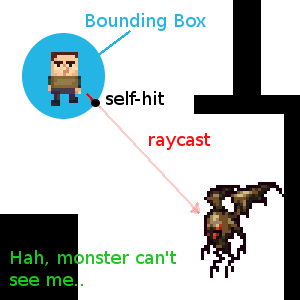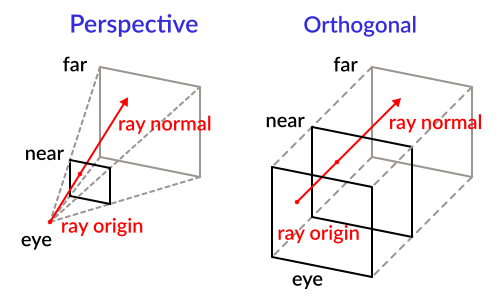Ray-casting¶
Introdução¶
Uma das tarefas mais comuns no desenvolvimento de um jogo é conjurar um raio (ou um objeto de formato personalizado) e verificar o que ele atinge. Isto permite comportamentos, IA, etc. complexos acontecerem. Este tutorial explicará como fazer isso em 2D e em 3D.
Godot armazena todas as informações de baixo nível em servidores, enquanto a cena é apenas uma interface. Assim, conjuração de um raio é geralmente uma tarefa de baixo nível. Para simples conjurações, nós como RayCast e RayCast2D funcionam, já que eles informam o resultado da conjuração a cada quadro.
Muitas vezes, entretanto, conjurar um raio precisa de um processo mais interativo, então deve existir uma maneira de fazer isso através de código.
Espaço¶
In the physics world, Godot stores all the low level collision and physics information in a space. The current 2d space (for 2D Physics) can be obtained by accessing CanvasItem.get_world_2d().space. For 3D, it's Spatial.get_world().space.
The resulting space RID can be used in PhysicsServer and Physics2DServer respectively for 3D and 2D.
Acessando o espaço¶
Godot physics runs by default in the same thread as game logic, but may be set to run on a separate thread to work more efficiently. Due to this, the only time accessing space is safe is during the Node._physics_process() callback. Accessing it from outside this function may result in an error due to space being locked.
To perform queries into physics space, the Physics2DDirectSpaceState and PhysicsDirectSpaceState must be used.
Use the following code in 2D:
func _physics_process(delta):
var space_rid = get_world_2d().space
var space_state = Physics2DServer.space_get_direct_state(space_rid)
public override void _PhysicsProcess(float delta)
{
var spaceRid = GetWorld2d().Space;
var spaceState = Physics2DServer.SpaceGetDirectState(spaceRid);
}
Ou mais diretamente:
func _physics_process(delta):
var space_state = get_world_2d().direct_space_state
public override void _PhysicsProcess(float delta)
{
var spaceState = GetWorld2d().DirectSpaceState;
}
E em 3D:
func _physics_process(delta):
var space_state = get_world().direct_space_state
public override void _PhysicsProcess(float delta)
{
var spaceState = GetWorld().DirectSpaceState;
}
Consulta de Raycast¶
For performing a 2D raycast query, the method Physics2DDirectSpaceState.intersect_ray() may be used. For example:
func _physics_process(delta):
var space_state = get_world_2d().direct_space_state
# use global coordinates, not local to node
var result = space_state.intersect_ray(Vector2(0, 0), Vector2(50, 100))
public override void _PhysicsProcess(float delta)
{
var spaceState = GetWorld2d().DirectSpaceState;
// use global coordinates, not local to node
var result = spaceState.IntersectRay(new Vector2(), new Vector2(50, 100));
}
The result is a dictionary. If the ray didn't hit anything, the dictionary will be empty. If it did hit something, it will contain collision information:
if result:
print("Hit at point: ", result.position)
if (result.Count > 0)
GD.Print("Hit at point: ", result["position"]);
The result dictionary when a collision occurs contains the following
data:
{
position: Vector2 # point in world space for collision
normal: Vector2 # normal in world space for collision
collider: Object # Object collided or null (if unassociated)
collider_id: ObjectID # Object it collided against
rid: RID # RID it collided against
shape: int # shape index of collider
metadata: Variant() # metadata of collider
}
The data is similar in 3D space, using Vector3 coordinates.
Exceções de colisão¶
A common use case for ray casting is to enable a character to gather data about the world around it. One problem with this is that the same character has a collider, so the ray will only detect its parent's collider, as shown in the following image:

To avoid self-intersection, the intersect_ray() function can take an
optional third parameter which is an array of exceptions. This is an
example of how to use it from a KinematicBody2D or any other
collision object node:
extends KinematicBody2D
func _physics_process(delta):
var space_state = get_world_2d().direct_space_state
var result = space_state.intersect_ray(global_position, enemy_position, [self])
class Body : KinematicBody2D
{
public override void _PhysicsProcess(float delta)
{
var spaceState = GetWorld2d().DirectSpaceState;
var result = spaceState.IntersectRay(globalPosition, enemyPosition, new Godot.Collections.Array { this });
}
}
The exceptions array can contain objects or RIDs.
Máscara de Colisão¶
While the exceptions method works fine for excluding the parent body, it becomes very inconvenient if you need a large and/or dynamic list of exceptions. In this case, it is much more efficient to use the collision layer/mask system.
The optional fourth argument for intersect_ray() is a collision mask. For
example, to use the same mask as the parent body, use the collision_mask
member variable:
extends KinematicBody2D
func _physics_process(delta):
var space_state = get_world().direct_space_state
var result = space_state.intersect_ray(global_position, enemy_position,
[self], collision_mask)
class Body : KinematicBody2D
{
public override void _PhysicsProcess(float delta)
{
var spaceState = GetWorld2d().DirectSpaceState;
var result = spaceState.IntersectRay(globalPosition, enemyPosition,
new Godot.Collections.Array { this }, CollisionMask);
}
}
See Exemplo de código for details on how to set the collision mask.
3D ray casting from screen¶
Casting a ray from screen to 3D physics space is useful for object picking. There is not much need to do this because CollisionObject has an "input_event" signal that will let you know when it was clicked, but in case there is any desire to do it manually, here's how.
Para converter um raio da tela, você precisa de um nó: ref: Camera <class_Camera>. Uma Camera pode estar em dois modos de projeção: perspectiva e ortogonal. Por causa disso, tanto a origem quanto a direção do raio devem ser obtidas. Isto é porque origin muda no modo ortogonal, enquanto normal muda no modo de perspectiva:

To obtain it using a camera, the following code can be used:
const ray_length = 1000
func _input(event):
if event is InputEventMouseButton and event.pressed and event.button_index == 1:
var camera = $Camera
var from = camera.project_ray_origin(event.position)
var to = from + camera.project_ray_normal(event.position) * ray_length
private const float rayLength = 1000;
public override void _Input(InputEvent @event)
{
if (@event is InputEventMouseButton eventMouseButton && eventMouseButton.Pressed && eventMouseButton.ButtonIndex == 1)
{
var camera = GetNode<Camera>("Camera");
var from = camera.ProjectRayOrigin(eventMouseButton.Position);
var to = from + camera.ProjectRayNormal(eventMouseButton.Position) * rayLength;
}
}
Remember that during _input(), the space may be locked, so in practice
this query should be run in _physics_process().